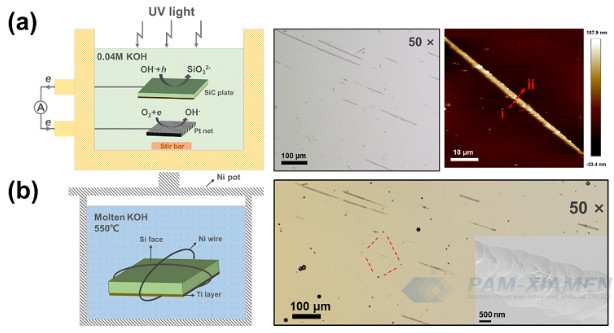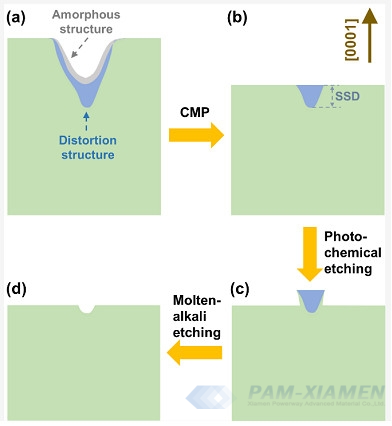Semiconductor silicon carbide (4H SiC) has excellent properties such as wide bandgap, high breakdown field strength, high electron mobility, high thermal conductivity, and good chemical stability. It has demonstrated important application potential in fields such as power electronics, radio frequency microwave, and quantum information. The 4H-SiC substrate is the fundamental material for various 4H-SiC devices. More SiC substrate specifications offered by PAM-XIAMEN please refer to https://www.powerwaywafer.com/sic-wafer/sic-wafer-substrate.html.
1. Why Should We Study the Sub Surface Damage of 4H-SiC Substrate?
The mechanical processing of 4H-SiC substrate mainly includes slicing, grinding, and chemical mechanical polishing. Due to the high hardness and brittleness of 4H-SiC, it is prone to significant damage during its machining process. Even though chemical mechanical polishing can provide a smooth surface suitable for epitaxial growth on 4H-SiC substrates, there may still be damage in their sub surface areas. These subsurface damages can serve as nucleation points for dislocations in the subsequent growth of 4H SiC epitaxial films, seriously affecting the quality of the 4H SiC epitaxial films.
At present, the properties and causes of sub surface damage on 4H-SiC substrates are not clear, making it difficult for researchers to develop targeted new processing techniques to eliminate them. Therefore, accurately identifying subsurface damage in 4H SiC substrates and elucidating its properties and origins is of great significance for improving the quality of 4H SiC substrates.
2. Research on 4H-SiC Subsurface Damage
Recently, researchers have accurately identified subsurface damage on 4H SiC substrates through photochemical corrosion, and analyzed the properties of subsurface damage through Raman spectroscopy and melt alkali corrosion.

Fig.1 (a) Schematic diagram of photochemical corrosion, as well as optical microscopy and atomic force microscopy images of subsurface damage on 4H-SiC substrate after photochemical corrosion; (b) Schematic diagram of molten alkali corrosion, as well as optical and scanning electron microscopy images of subsurface damage on 4H-SiC substrate after molten alkali corrosion.

Fig. 2 (a) Grinding; (b) Chemical mechanical polishing; (c) Photochemical corrosion; And (d) schematic diagram of 4H-SiC substrate and its sub surface damage after molten alkali corrosion.
The research results indicate that subsurface damage is still crystalline and is only affected by stress. After molten alkali corrosion, the morphology of sub surface damage is similar to that of surface scratches in molten alkali corrosion, and its size is similar to the abrasive particle size used during the grinding process. This indicates that the sub surface damage in the 4H SiC substrate is mainly introduced by substrate grinding, rather than by chemical mechanical polishing.
In order to suppress subsurface damage, it is necessary to improve the substrate grinding process or extend the chemical mechanical polishing time to fully remove the damage layer introduced by grinding. This will contribute to the development of high-quality 4H-SiC substrate processing technology.
For more information, please contact us email at victorchan@powerwaywafer.com and powerwaymaterial@gmail.com.

